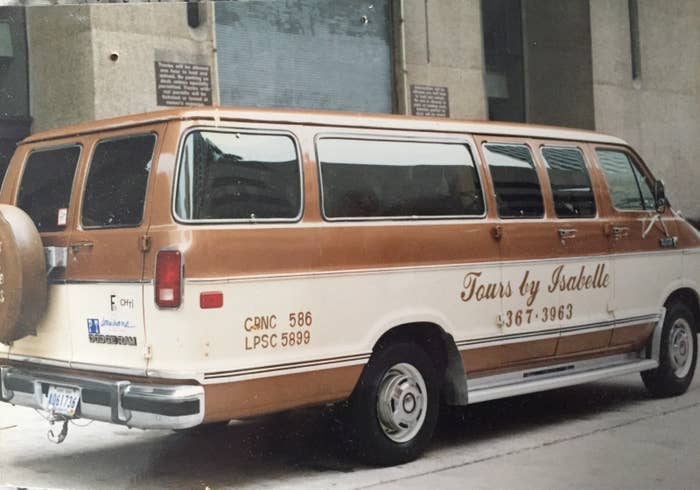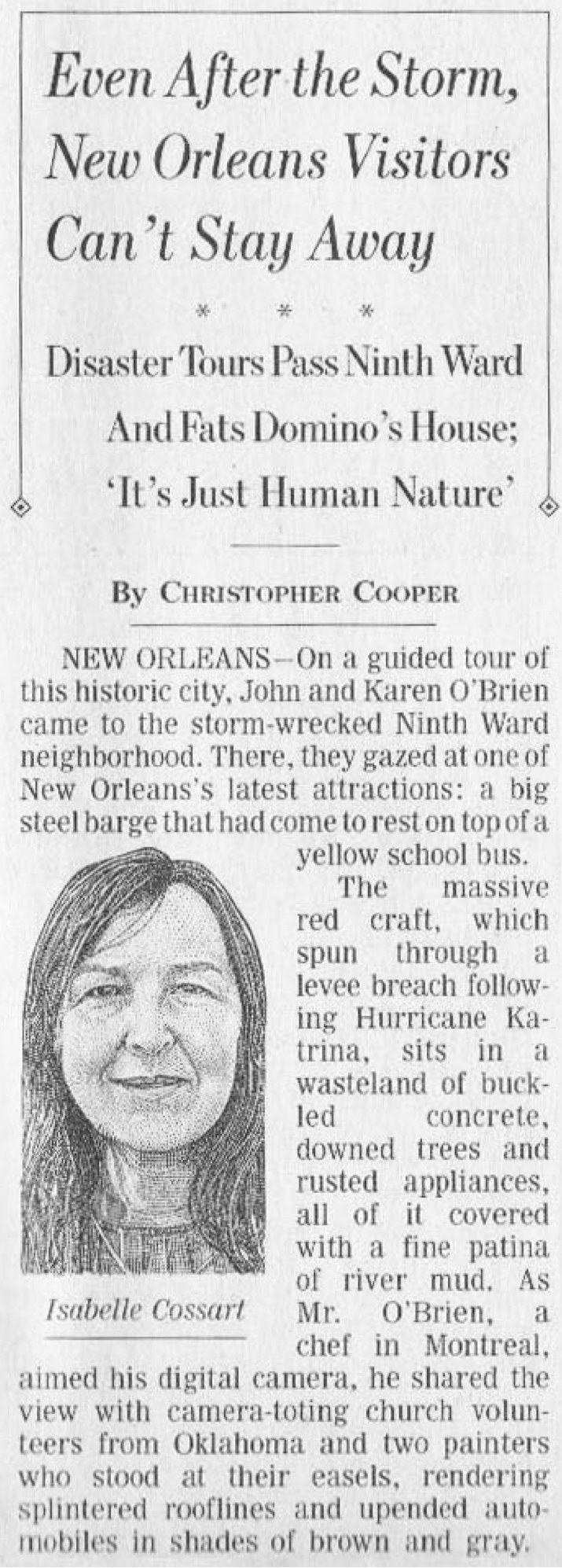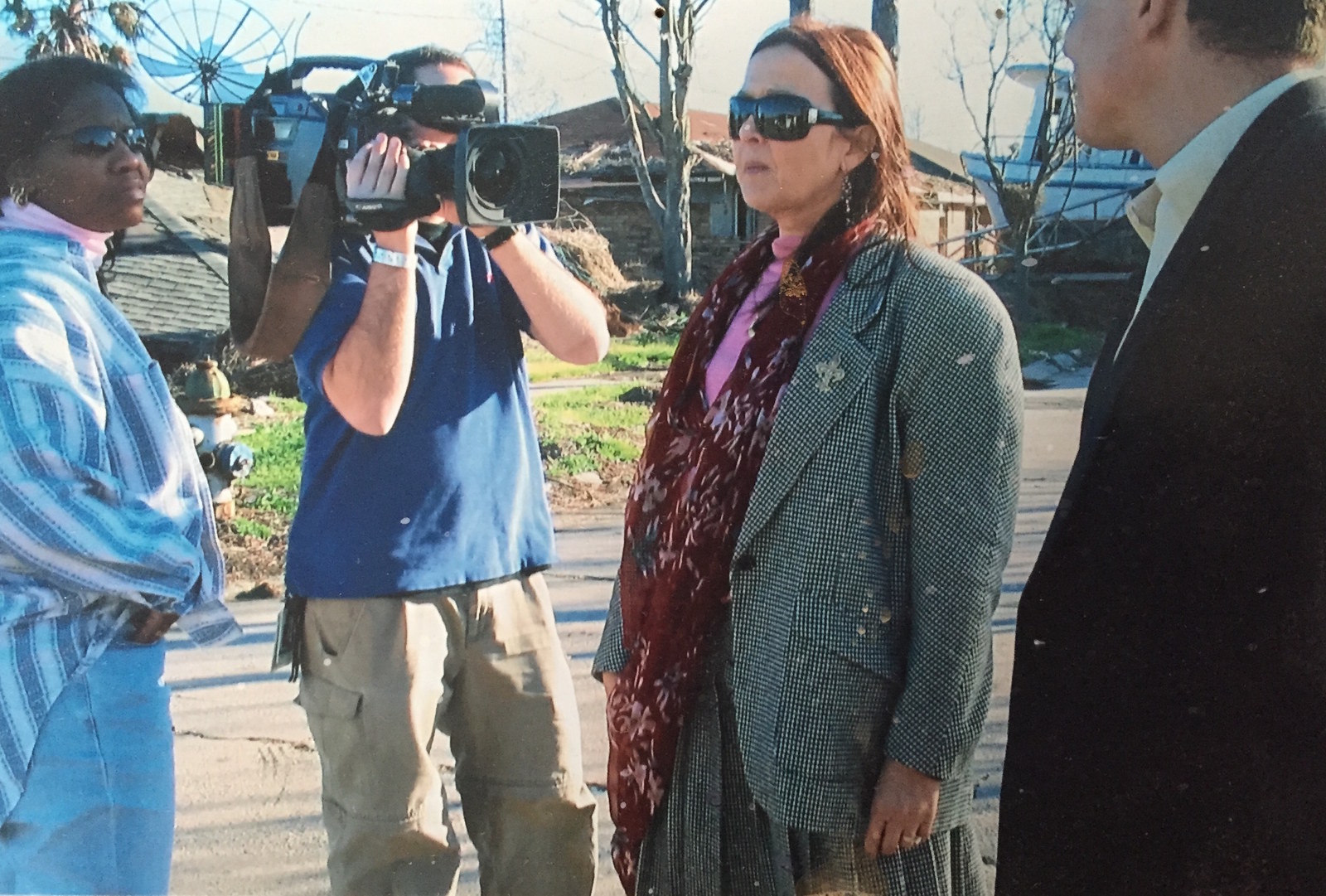
I came to New Orleans from France in 1975, when I was 21 years old, for what was supposed to be a one-year teaching assignment at a city public school. To make extra money, I substituted for a friend on a few tour guide assignments for French tourists. As my English improved — and as I learned more about the city’s history and culture — the concierges at various hotels encouraged me to give tours of my own. Less than five years later, I convinced a banker to loan me enough money to buy a used 15-passenger van, and Tours By Isabelle was born. My company motto? “We’ll make you fall in love with Louisiana.”
Forty years later, I’m still in New Orleans and still giving tours. But for the past 10 years, the job has included sharing some of the darkest moments in Louisiana’s history. In the fall of 2005, the demand for tours showing the destruction wrought by Hurricane Katrina became impossible to ignore. It was the only thing customers asked for.
Similar tours cropped up near the sites of the tornadoes in Joplin, Missouri, and the meltdown at Japan’s Fukushima nuclear plant, seeming to draw tourists and controversy in equal measure. Some argued that these tours exploit the victims of these tragedies and make a spectacle of human suffering. Others argued they’re merely in poor taste. Dubbed “disaster tourism,” it’s not an industry I ever hoped to get into. But it’s also one I don’t think I could have avoided.

When The Storm — which is what most people here call it, so as not to say her name — hit, I evacuated to my sons’ college apartment in Baton Rouge. When I came back about a month later, there were no more tourists. I laid off my 12 employees and sold four of my five tour vans to the Red Cross and to Habitat for Humanity. I rented out my office parking lot to contractors from Tennessee who lived there in their RV. They had a contract from FEMA and were working in tree debris removal.
I found my beloved yellow ‘Vette flattened like a banana pancake in my driveway under my neighbor’s pecan tree, so I used my last tour van working as a courier for my bank. For six weeks I drove boxes of files and canceled checks from my bank to and from a warehouse outside the city, avoiding flooded streets. I hated it. You can’t talk to boxes! I learned to keep two spare tires in the van; flats were common with debris everywhere. For a while, I drove a shuttle for volunteers and rescuers, ferrying them from hotels to cleanup sites and counseling centers in tents.
Around the beginning of October, I started to get phone calls from insurance adjusters and Red Cross staffers, asking for tours of flooded New Orleans. Their spouses were coming to visit them and they wanted to show them what they had been working on, including the devastated areas.
At first, I was shocked. I couldn’t imagine why anyone would want to tour the nightmarish scenes we were living among. The eery quiet (all the birds had left), the relentless brown and gray (the colors left as well), the moldy homes vomiting stinky, rotten furniture. Cars on top of trees, refrigerators on top of roofs, kids bikes hanging from the top of fences. The cryptic markings rescuers left on the front of homes, right above the black flood lines read: “gas leak,” “2 cats under house,” “one dead in the attic.”
But then I remembered my own grim vacations visiting a Nazi concentration camp and the sites of other war crimes as a teenager. It was only human nature, I figured, for people to want to see for themselves what’s happened here. And besides, I desperately needed the work.
It was only human nature. And I needed the work.
I got a city map and tried to figure out a route for what I called the Katrina Disaster Sites Tour. I wanted to find out how to safely access and show the different levee failures and floodwall breaches — difficult because so many underpasses were still flooded. I asked my tenants, the Tennessee contractors, to show me how they got to work. But because all the street signs had been carried away by the wind and the flood, they could not tell me where they worked.
After a couple of weeks, I had my route. Using my granddaughter’s crayons, I highlighted four neighborhoods on the map. The first was a mixed, middle class area called Gentilly and the second was the affluent Lakeview neighborhood. Both had been hit by sudden rising waters during the storm and soaked for weeks in six to ten feet of brackish water because of collapsed flood walls. The third was the town of Chalmette, ruined by the one-two punch of the 40 Arpent Canal overtopping and the Murphy Refinery oil spill.
The fourth stop on the tour was the Lower Ninth Ward, the working-class, African-American neighborhood Katrina simultaneously put on the map and wiped off it. We ended the tour where the flood walls of the Industrial Canal had broken. People liked to take pictures of the red barge that swept into the gaping hole with the rushing floodwater, leveling homes beneath it.
All in all, my narrated tour covered 49 miles. It took three and a half hours. It showed seven areas of flood wall failures and levee breaches. For two months, I gave this tour by myself. I wanted to show people Katrina was not a natural disaster, it was a man-made one. All of the old earthen levees along the Mississippi River and along Lake Pontchartrain (built in 1928) held. None of the bayous overtopped. Every Katrina failure in New Orleans occurred in man-made flood walls along our drainage canals, built — defectively — by the Army Corps of Engineers to direct tropical rain water out of the city.
I gathered data and information from our local newspaper, the Times-Picayune. I thought I had a responsibility, like a journalist, to tell every visitor the truth of this disaster and its crazy scope, its ugly and unjust consequences in terms of lives lost and property destroyed. I asked customers to ask their lawmakers to hold the Army Corps of Engineers accountable for their mistakes.
Customers always had two reactions. They could not believe the depth of the damage, and they were shocked by the size of the area devastated. The devastation zone covered 144 square miles, an area seven times larger than Manhattan. The federal disaster declarations covered 90,000 square miles — an area almost as large as the U.K. Tourists stopped asking for our scenic plantation and swamp tours, and didn’t start again until late 2006.

Giving tours was all that remained from their lives before the Storm.
Soon, other Katrina tours started, and I became one of the faces of this new, exploitative industry, portrayed as adding insult to the injury of the storm. When my father came to visit from France that December, he called me from the airport to say he was buying every issue he could find of the Wall Street Journal. On the front page, there was a stipple drawing of his daughter. “Even after the Storm, New Orleans visitors can’t stay away, disaster tours pass Ninth Ward and Fats Domino’s house,” the paper said.
Later, Connie Chung interviewed me on a local NBC affiliate. "Don't you have mixed feelings about this being voyeurism?" she asked. "You charge people for gawking at others' misery; don’t you feel bad about profiting by doing the Katrina disaster tour?”
I was furious. What was television news if not gawking at and profiting off others’ misery? I wanted to point out the hypocrisy, but my mic was cut off. I also wanted to say that my Katrina tour was done in a sensitive manner. After all, most of the driver-guides had themselves lost everything they owned.
In fact, the Katrina tour was so mind-numbingly bleak that I worried about my driver-guides, and asked if they were up for it. Two of them had lived in Chalmette and lost everything — homes, cars, communities. They begged me not to stop giving the tour. The job was the only thing that remained from their lives before the storm. We were not some big international tourism company swooping in to cash in on others’ misery. It was our misery too. Giving tours was part of the life we were trying to pick back up, just like the residents of the neighborhoods through which we toured.
Our mission was to explain to as many people as we could exactly what happened here. And unlike the procession of tourists in cars, stopping to trespass and steal mementos, we could contain our audience. I never allowed tourists to get out and take photographs in the areas where refugees in white hazmat suits came on the weekends to sift through the flood-soaked contents of their ruined homes.
Nonetheless, in 2006, the New Orleans City Council made it illegal for tour operators to give tours “east of the Industrial Canal,” meaning in the Lower Ninth Ward. I couldn’t believe it — my own personal law. Some of the desolate Ward’s few remaining residents had complained that they were tired of tour buses passing by, gawking at their ruined community, adding to the traffic of debris removal trucks.

This is the difference between a Katrina tour and the horrible sites I saw as a teenager. Unlike a concentration camp, the areas affected by the storm are not sealed-off memorials. They are living communities. At the time, they were communities on life support.
I stopped driving my tour van down to the Lower Ninth Ward, but I did not stop operating so-called disaster tourism. There was no shortage of ugliness elsewhere in the city, and the demand for the Katrina tour kept my employees and me in business. By the time the much larger, national Gray Line bus tour company started doing its own Katrina tour in 2006, I was sick of it. Each tour felt like reliving a nightmare.
But it was the only way I could earn a living. Thanks to the Katrina tour's popularity, I was able to buy two more vans and hire back some of my workers.
Over the years, the route of what we now call the Post Katrina tour has changed remarkably little. The content of the tour, however, has become more upbeat. I now pass Harry Connick Jr. and Branford Marsalis’s Musicians' Village — a Habitat for Humanity neighborhood built in 2007. In Faubourg Treme, the horrendous Lafitte housing projects have been replaced by nice new townhouses built by the Department of Housing and Urban Development.
I also drive by some of the 101 homes rebuilt there by Project Home Again, the result of a $20 million gift by Barnes & Noble chairman Len Riggio. I stop to visit the Levee Exhibit Hall and Rain Garden that now stands where the London Avenue flood wall broke. It’s not the romantic history that made me fall in love with New Orleans 40 years ago, but the sheer resilience and generosity that were revealed by the Storm are also beautiful to me.
New Orleans is worth rebuilding for the simple reason that New Orleanians love it.
When customers ask why we should bother to rebuild here, below sea level, we explain why New Orleans is worth saving. The country needs us for the oil and gas facilities, for the seafood industry, for the port’s export business. And New Orleans is worth rebuilding for the simple reason that New Orleanians love it right here.
The Post Katrina tour was good for business in the sense that it kept my business alive. It was the only tour I was asked to give until the end of 2006. Then, slowly, demand trickled back for my tours of swamps and plantations. Nobody has objected to the latter, even though it too covers the site of historical atrocities. (As of recently, our plantation tour offerings include a stop at the Whitney Plantation’s new Museum of Slavery.)
By 2012, demand for the Post Katrina tour dwindled and we scaled it back to a portion of our regular city tour. But it's still available by special request, and, 10 years later, people ask for it once in a while. After all, it’s still human nature to be curious. And I’m confident it can make you fall in love with Louisiana.
